Sheikh Zayed Mosque
| Sheikh Zayed Grand Mosque | |
|---|---|
| جامع الشيخ زايد الكبير | |
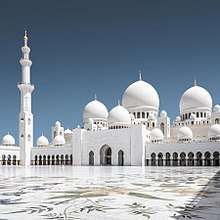 Sheikh Zayed Mosque as seen from the outside. | |
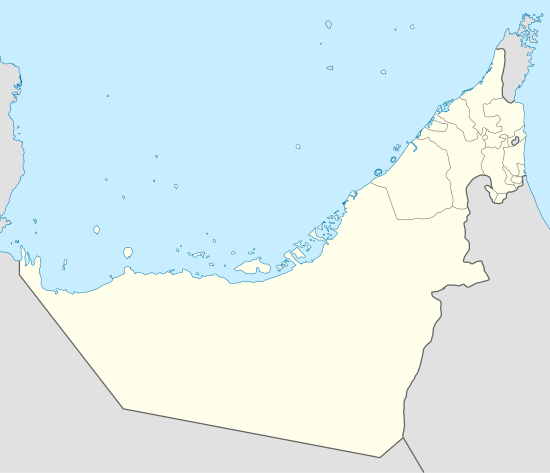 Location in the United Arab Emirates | |
| Basic information | |
| Location | Abu Dhabi, U.A.E. |
| Geographic coordinates | 24°24′43″N 54°28′26″E / 24.412°N 54.474°ECoordinates: 24°24′43″N 54°28′26″E / 24.412°N 54.474°E |
| Affiliation | Islam |
| Branch/tradition | Sunni Islam (Malikite) |
| Ownership | Government |
| Architectural description | |
| Architectural type | Mosque |
| Groundbreaking | 1996 |
| Completed | 20 December 2007 |
| Construction cost |
2 billion dirhams (US$545 million) |
| Specifications | |
| Capacity | over 41000 |
| Length | 420 m (1,380 ft) |
| Width | 290 m (950 ft) |
| Dome(s) | 82 domes of seven different sizes |
| Dome height (outer) | 85 m (279 ft) |
| Dome dia. (outer) | 32.2 m (106 ft) |
| Minaret(s) | 4 |
| Minaret height | 107 m (351 ft) |
Sheikh Zayed Grand Mosque (Arabic: جامع الشيخ زايد الكبير) is located in Abu Dhabi, the capital city of the United Arab Emirates.[1] The largest mosque in the country, it is the key place of worship for daily prayers , Friday gathering and Eid prayers. During Eid it may be visited by more than 41,000 people.[1]
The Grand Mosque was constructed between 1996 and 2007.[2] It was designed by Syrian architect Yousef Abdelky.[3] The building complex measures approximately 290 m (960 ft) by 420 m (1,380 ft), covering an area of more than 12 hectares (30 acres), excluding exterior landscaping and vehicle parking.[4]
The project was launched by the late president of the United Arab Emirates (UAE), Sheikh Zayed bin Sultan Al Nahyan, who wanted to establish a structure that would unite the cultural diversity of the Islamic world with the historical and modern values of architecture and art.[5] His final resting place is located on the grounds adjacent to the complex.
Sheikh Zayed Grand Mosque Center (SZGMC) offices are located in the west minarets. SZGMC manages the day-to-day operations and serves as a center of learning and discovery through its educational cultural activities and visitor programs.
The library, located in the northeast minaret, serves the community with classic books and publications addressing a range of Islamic subjects: sciences, civilization, calligraphy, the arts, and coins, including some rare publications dating back more than 200 years. The collection comprises material in a broad range of languages, including Arabic, English, French, Italian, Spanish, German, and Korean.
For two years running, it was voted the world's second favorite landmark by TripAdvisor.[6]
Design and construction
The design of the Sheikh Zayed Mosque has been inspired by Persian, Mughal, and the Alexandrian Mosque of Abu al-Abbas al-Mursi Mosque in Egypt, also the Indo-Islamic mosque architecture, particularly the Badshahi Mosque in Lahore, Pakistan being direct influences. The dome layout and floorplan of the mosque was inspired by the Badshahi Mosque. Its archways are quintessentially Moorish and its minarets classically Arab.
Under lead contractor Impregilo (Italy), more than 3,000 workers and 38 sub-contracting companies took part in its construction. Natural materials were chosen for much of its design and construction due to their long-lasting qualities, including marble stone, gold, semi-precious stones, crystals and ceramics. Artisans and materials came from many countries including India, Italy, Germany, Egypt, Turkey, Morocco, Pakistan, Malaysia, Iran, China, United Kingdom, New Zealand, Republic of Macedonia and United Arab Emirates.
Dimensions and statistics
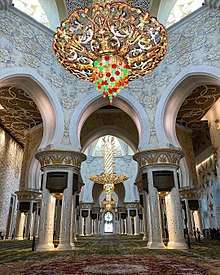
The mosque is large enough to accommodate over 40,000 worshippers, while the main prayer hall can hold over 7,000. There are two smaller prayer halls, with a capacity of 1,500 each, one of which is the women's prayer hall.[1]
There are four minarets on the four corners of the courtyard which rise about 107 m (351 ft) in height. The courtyard, with its floral design, measures about 17,000 m2 (180,000 sq ft), and is considered to be the largest example of marble mosaic in the world.[1]
- Sivec from Prilep, Macedonia was used on the external cladding (115,119 m2 (1,239,130 sq ft) of cladding has been used on the mosque, including the minarets)
- Lasa from Laas, South Tyrol, Italy was used in the internal elevations
- Makrana from Makrana, India was used in the annexes and offices
- Acquabianca and Bianco P from Italy
- East White and Ming Green from China[1]
Key architectural features
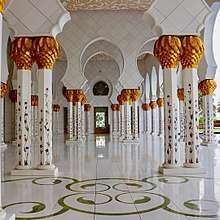
The Sheikh Zayed Grand Mosque has many special and unique elements: The carpet in the main prayer hall is considered to be the world's largest carpet made by Iran's Carpet Company and designed by Iranian artist Ali Khaliqi.[7] This carpet measures 5,627 m2 (60,570 sq ft), and was made by around 1,200-1,300 carpet knotters. The weight of this carpet is 35 ton and is predominantly made from wool (originating from New Zealand and Iran). There are 2,268,000,000 knots within the carpet and it took approximately two years to complete.[1]
The Sheikh Zayed Grand Mosque has seven imported chandeliers from the company Faustig in Munich, Germany that incorporate millions of Swarovski crystals. The largest chandelier is the second largest known chandelier inside a mosque, the third largest in the world and has a 10 m (33 ft) diameter and a 15 m (49 ft) height.[1] The pools along the arcades reflect the mosque's spectacular columns, which becomes even more glorious at night. The unique lighting system was designed by lighting architects Speirs and Major Associates to reflect the phases of the moon. Beautiful bluish gray clouds are projected in lights onto the external walls and get brighter and darker according to the phase of the moon.
The 96 columns in the main prayer hall are clad with marble and inlaid with mother of pearl, one of the few places where you will see this craftsmanship.
The 99 names (qualities or attributes) of God (Allah) are featured on the Qibla wall in traditional Kufic calligraphy, designed by the prominent UAE calligrapher — Mohammed Mandi Al Tamimi. The Qibla wall also features subtle fibre-optic lighting, which is integrated as part of the organic design.
In total, three calligraphy styles — Naskhi, Thuluth and Kufic — are used throughout the mosque and were drafted by Mohammed Mandi Al Tamimi of the UAE, Farouk Haddad of Syria and Mohammed Allam of Jordan.[1]
Controversy
In 2013, US-based singer Rihanna received negative criticism for taking photographs, with the Mosque in the background, during a private visit. During the incident she was reported to have posed in a manner deemed offensive and provocative. Staff asked her to leave following the incident.[8]
More recently, Selena Gomez was criticised by Instagram users for posing for pictures at the mosque with her ankle shown.[9]
Gallery
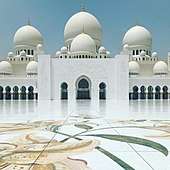 Front View of Sheikh Zayed Mosque.
Front View of Sheikh Zayed Mosque.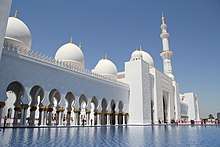 Outer entrance of the Sheikh Zayed Mosque.
Outer entrance of the Sheikh Zayed Mosque. Water mirror and columns.
Water mirror and columns.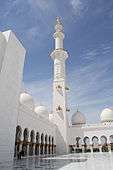 Inner Court Yard with Minaret.
Inner Court Yard with Minaret.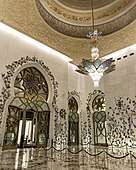 Interior of Sheikh Zayed Mosque in Abu Dhabi showing the initial entrance to the mosque.
Interior of Sheikh Zayed Mosque in Abu Dhabi showing the initial entrance to the mosque. Interior of the Main Prayer Hall in Sheikh Zayed Mosque.
Interior of the Main Prayer Hall in Sheikh Zayed Mosque.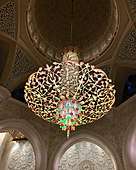 Interior of Sheikh Zayed Mosque in Abu Dhabi showing the chandelier.
Interior of Sheikh Zayed Mosque in Abu Dhabi showing the chandelier.
See also
- Timeline of Muslim history
- List of mosques in the United Arab Emirates
- Sheikh Zayed Mosque, Fujairah, second largest mosque in the UAE
References
- 1 2 3 4 5 6 7 8 "Sheikh Zayed Grand Mosque in Abu Dhabi". www.szgmc.ae.
- ↑ "Sheikh Zayed Grand Mosque History". Abu Dhabi Government. Retrieved 26 February 2014.
- ↑ "Yousef Abdelky | ArchiTravel". www.architravel.com. Retrieved 2017-06-24.
- ↑ The main axis of the building is rotated about 11° south of true west, aligning it in the direction of the Kaaba in Mecca, Saudi Arabia. Dimensions and alignment are estimated from satellite images; this information is not available at the Sheikh Zayed Mosque Web site as of 2014.
- ↑ "Sheikh Zayed Mosque, Abu Dhabi". Wondermondo.
- ↑ The National staff (27 May 2017). "Sheikh Zayed Grand Mosque ranked world's second favourite landmark | The National". Retrieved 28 May 2017.
- ↑ "Iran weaves world's largest carpet". news.webindia123.com.
- ↑ "Sheikh Zayed Mosque Rihanna Photo Shoot: Muslims React To Abu Dhabi Incident". The Huffington Post. 21 October 2013. Retrieved 11 January 2015.
- ↑ Pleasance, Chris (1 January 2015). "Selena Gomez pulls down Instagram picture that infuriated Muslims because she was displaying her ANKLES during visit to Abu Dhabi mosque". Daily Mail. London. Retrieved 11 January 2015.
External links
- The Official Sheikh Zayed Grand Mosque Center Website
- The Official Abu Dhabi Tourism Authority Website
| Wikimedia Commons has media related to Sheikh Zayed Mosque. |
